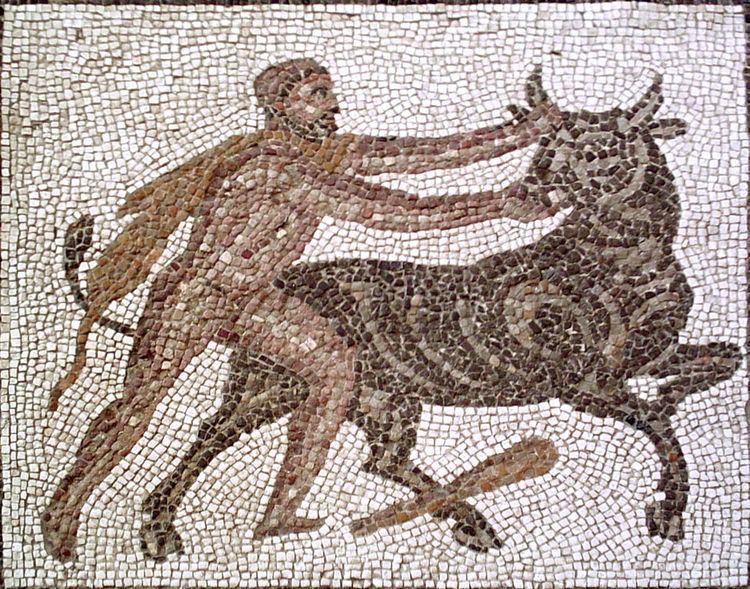 | ||
In Greek mythology, the Cretan Bull (Greek: Κρὴς ταῦρος) was the bull Pasiphaë fell in love with, giving birth to the Minotaur.
Contents
Background
Minos was King in Crete. In order to confirm his right to rule, rather than any of his brothers, he prayed Poseidon send him a snow white bull as a sign. Poseidon sent Minos the bull, with the understanding that it would be sacrificed to the god. Deciding that Poseidon's bull was too fine a specimen to kill, Minos sent it to his herds and substituted another, inferior bull for sacrifice. Enraged, Poseidon had Aphrodite cause Pasiphae, wife of Minos, to fall in love with the bull. She subsequently gave birth to the half-man, half-bull, Minotaur. Poseidon passed on his rage to the bull, causing it lay waste the land.
After consulting the oracle at Delphi, Minos had Daedalus construct the Labyrinth to hold the Minotaur.
The Seventh Labour of Heracles
Heracles was sent to capture the bull by Eurystheus as his seventh task. He sailed to Crete, whereupon Minos gave Heracles permission to take the bull away as it had been wreaking havoc on Crete by uprooting crops and leveling orchard walls. Heracles captured the bull, and then shipped it to Eurystheus in Tiryns. The bull later broke loose and wandered into Marathon, becoming known as the "Marathonian Bull". Eurystheus then sent Heracles to bring back the man-eating Mares of Diomedes ( the next task).
Capture by Theseus
Androgeus, a son of Minos and Pasiphaë, competed in the games held by Aegeus, King of Athens. He won all the games, so angering Aegeus that he had the young man killed (some legends claim that he was sent to confront the Bull itself). Devastated, Minos went to war with Athens and won. As punishment, the Athenians had to send several youths every 9 years to be devoured by the Minotaur.
Theseus set to try to capture the Bull. On the way to Marathon, Theseus sought shelter from a storm in the shack owned by an old lady named Hecale. She swore to make a sacrifice to Zeus if Theseus was successful in capturing the bull. Theseus did capture the bull, but when he returned to Hecale's hut, she was dead. Theseus built a deme in her honor. He then dragged the Bull to Athens where he sacrificed it to Athena and/or Apollo. Theseus then went to Crete where he killed the Minotaur with the help of Minos' daughter Ariadne.
Origin
According to Jeremy McInerney, the iconography of the bull permeates Minoan culture. The cult of the bull was also prominent in southwestern Anatolia. Bernard Clive Dietrich notes that the most important animal in the Neolithic shrines at Çatalhöyük was the bull. The bull was a chthonic animal associated with fertility and vegetation. It figured in cave cults connected with rites for the dead.
The palace at Knossos displays a number of murals depicting young men and women vaulting over a bull. While scholars are divided as to whether or not this reflects an actual practice, Barry B. Powell suggests it may have contributed to the story of the young Athenians sent to the Minotaur. McInerney observes that the story of Pasiphae and the Cretan bull were not written until after Crete had come under Greek control. Emma Stafford notes that the story of the Cretan Bull does not appear before the Hellenistic period and suggests the connection between Crete and Athens is the result of the development of the myth of the Theseus cycle in late sixth century Athens.
In popular culture
In the 2005 Hercules miniseries, the Bull is portrayed as a Antaeus.
